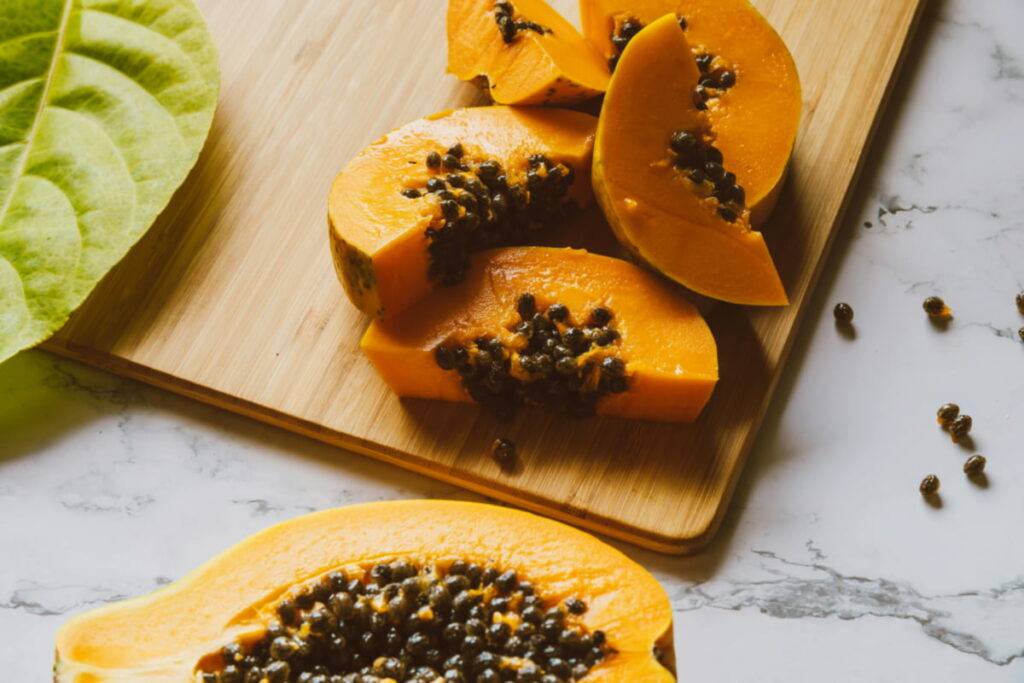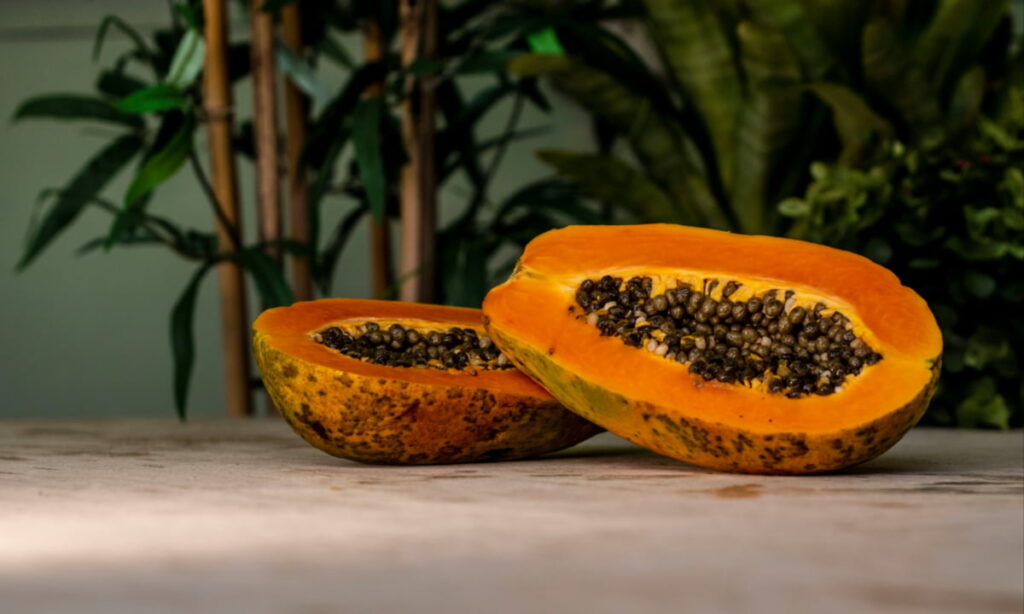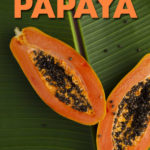
It still makes me laugh that freezing papaya has become part of my weekly routine. I started doing it just to save ripe fruit before it spoiled, but it’s turned into one of my favorite kitchen habits.
Now I always keep frozen papaya on hand for smoothies, or even quick snacks. It’s simple, practical, and honestly, I don’t know why I wasn’t doing it all along.
Which brings up the question I get most often: can you actually freeze papaya without ruining it? Spoiler, you can, and it’s easier than you think.
Yes, You Can Freeze Papaya, Here’s Why It Works

Freezing papaya might sound like a tropical experiment, but it actually works really well. The key is knowing what happens to the fruit once it’s frozen, and why that’s a good thing.
- Papaya freezes beautifully: Ripe fruit is full of sugar and water, so it freezes easily. The texture softens a bit, but the flavor stays bright and tropical.
- Texture change = creamier blends. Once frozen, papaya turns silky, perfect for smoothies, sorbets, and frozen desserts. Not great for fruit salads, but ideal for anything blended.
- Color and nutrients hold up. Proper freezing keeps its orange color and most vitamins. The University of Minnesota Extension says frozen produce keeps nutrients almost as well as fresh.
- Freezing locks in flavor and safety. The U.S. Department of Agriculture notes that freezing at 0°F stops bacterial growth and preserves flavor for months.
So, basically you can freeze papaya, and you probably should. It’s one of those simple tricks that saves ripe fruit from the compost bin, cuts down waste, and keeps a little taste of the tropics in your freezer year-round.
Related Posts: Can You Freeze Kiwi?
What I’ve Learned Freezing Papaya Over Time

When I first started freezing papaya, I thought it would be foolproof, just slice, toss it in a bag, and done. I was wrong. My first few batches turned into solid orange blocks or lost that bright color I loved. But over time, I figured out what works, what doesn’t, and how to make it effortless.
Here’s what I’ve learned:
- Ripeness matters. The best papayas to freeze are fully orange and fragrant but still a little firm. Overripe ones turn slushy; underripe ones never develop that deep sweetness.
- Pre-freezing makes a difference. Laying out the pieces on a tray before packing keeps them separate instead of fusing into one icy chunk.
- Keep the cubes dry. A quick pat with a towel before freezing cuts down on ice crystals and keeps the texture smoother.
- A touch of citrus helps. A drizzle of lime or lemon juice brightens the flavor and helps the color stay vibrant.
- Portion what you’ll actually use. I used to fill huge bags, then only need a handful for a smoothie. Now I freeze smaller batches, one smoothie’s worth at a time.
- Label everything. It sounds simple, but it’s easy to forget when things were frozen. I add the date and portion size right on the bag.
Now, freezing papaya feels like second nature. It’s no longer about saving fruit, it’s about always having something bright and tropical ready whenever I need it.
How to Freeze Papaya (Step-by-Step)

I’ve learned there are two simple ways to freeze papaya, and I use both depending on what I’m making. One’s perfect if you want exact portions for smoothies, and the other’s quick and effortless when you just want to save fruit before it spoils.
Method 1: Cubes for Measured Portions
This is the way to go if you like having set amounts for smoothies, recipes, or meal prep.
- Choose ripe papayas, fully orange, sweet, and slightly firm.
- Peel, seed, and cut into even 1-inch cubes.
- Pat dry to remove excess moisture (this helps prevent icy buildup).
- Spread the cubes on a baking sheet in a single layer and freeze for 2–3 hours.
- Once firm, transfer to bags or containers, pressing out as much air as possible.
- Label and portion about 1 cup per bag, the perfect amount for one smoothie.
This gives you clean, ready-to-use portions that stay separate and blend like a dream.
Method 2: Quick Batch-Freezing (My “Life Happens” Way)
Sometimes, I don’t measure, I just need to save the fruit before it turns.
- Peel and cut the papaya into chunks or slices (size doesn’t need to be perfect).
- Lay the pieces on a tray and freeze for a few hours until firm.
- Then bag them all together, no measuring, no fuss.
This method is great when you have a pile of papayas ripening at once and just want to preserve them fast. The pieces might stick a little, but a quick tap on the counter loosens them.
Whether you cube carefully or just cut and freeze, both ways work. One’s about precision, the other’s about practicality, and honestly, I use them both.
Storage & Shelf Life
Once you’ve frozen the papaya, how you store it makes all the difference in keeping that fresh, tropical flavor. I’ve learned that a few small habits can completely change the quality months later.
- Use the right bags or containers. Reusable silicone pouches or thick freezer bags work best. They press flat, save space, and keep air out to prevent freezer burn.
- Label and date everything. A quick label saves the guessing later. I jot down the date and portion size, something like “Papaya cubes – July 10.”
- Store it deep in the freezer. The back stays coldest and most consistent. The door warms up when opened, which can affect texture.
- Best quality within 3 months. Papaya keeps beautifully for about three months, but stays safe longer at 0°F. University of Minnesota Extension notes that freezing stops spoilage and keeps fruit safe for months.
- Don’t refreeze thawed papaya. Once it softens, the texture breaks down. I only thaw what I’ll use and keep the rest frozen for next time.
My freezer usually has a few labeled bags stacked flat like little slices of summer, easy to grab, quick to blend, and always tasting like sunshine.
How to Use Frozen Papaya

This is the fun part, turning those neat little bags of frozen papaya into something delicious. Once you’ve frozen it, you’ll realize how versatile it really is.
- Smoothies. This is my everyday use. Frozen papaya blends into a creamy, rich texture that doesn’t need ice. I mix one cup of cubes with banana, coconut water, and a splash of lime juice.
- Smoothie bowls. Slightly thaw the cubes before blending and top with granola, seeds, or shredded coconut. It feels like a tropical breakfast you’d get on vacation.
- Sorbet or “nice cream.” Blend frozen papaya with a drizzle of honey and freeze it again for a soft-serve texture. It’s fresh, sweet, and dairy-free.
- Frozen fruit cubes for drinks. Add papaya chunks to sparkling water or mocktails, they chill and infuse flavor at the same time.
- Popsicles or purée pucks. Blend papaya with coconut milk or juice, pour into molds, and freeze. It’s my favorite way to use up any leftover cubes.
- Quick snacks. Sometimes, I just eat the frozen cubes straight from the bag, they’re surprisingly refreshing on a hot day.
After a while, frozen papaya just becomes part of your kitchen rhythm, ready for breakfasts, desserts, or quick tropical moments whenever you need them.
Why I’ll Never Stop Freezing Papaya
What started as a quick way to save fruit turned into one of my favorite kitchen habits. It’s easy, it saves money, and it keeps that tropical flavor ready all year. Now, freezing papaya isn’t just practical, it’s part of my rhythm.
If you haven’t tried it yet, give it a shot. You might be surprised at how creamy your smoothies turn out, and how much fruit you actually save.
Do you freeze papaya a different way? I’d love to hear how it works for you in the comments. And if you want more simple freezing tips and guides, check out my tips for freezing fruit, herbs, and leftovers, for more ideas like this.
